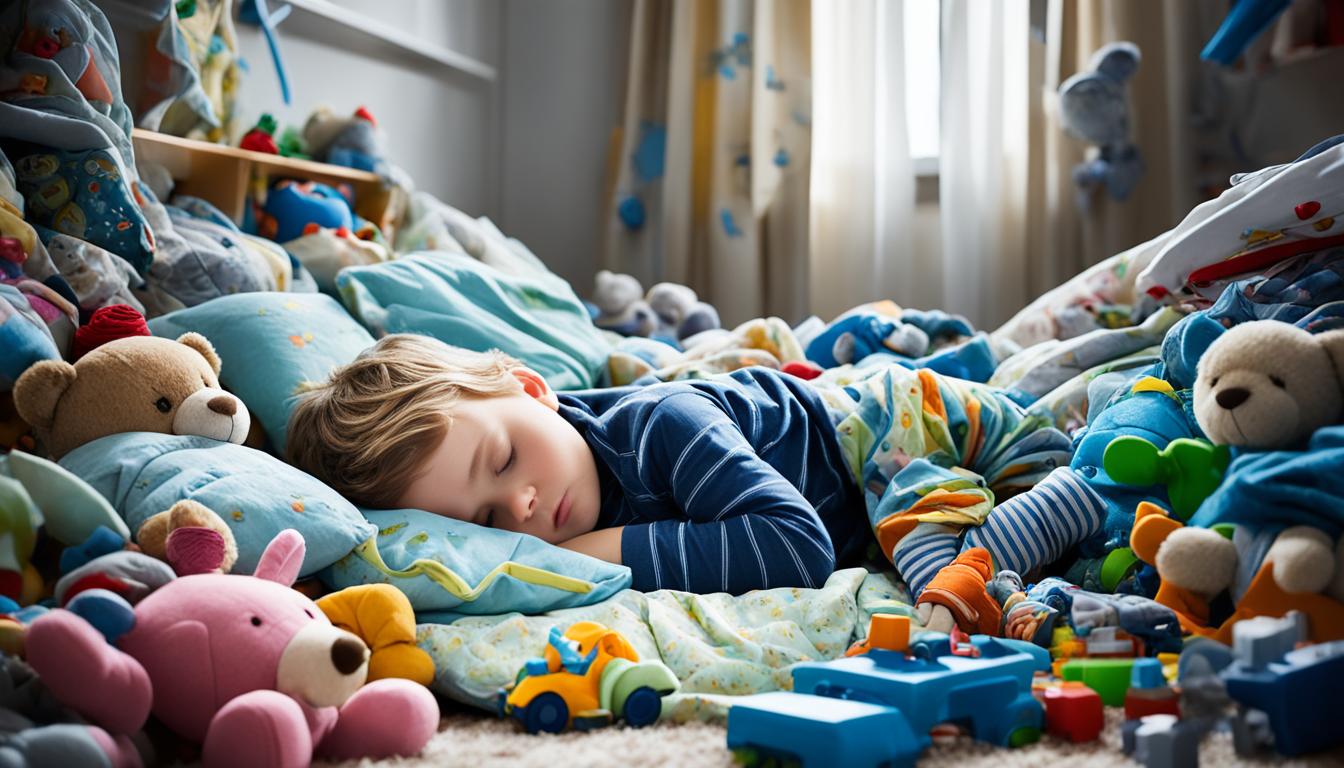
Child Sleep Patterns Over 5 Years: Long-Term Effects
Understanding the sleep patterns of children is crucial for their long-term development and well-being. As parents and caregivers, we strive to create a room environment that promotes their comfort and supports healthy sleep habits. In this article, we will explore how a child’s sleep patterns evolve over a span of 5 years and the significant impact the room environment can have on their sleep quality, comfort, and overall development.
During the early years, infants have unique sleep patterns characterized by frequent waking, shorter sleep cycles, and irregular sleep schedules. As they grow, their sleep patterns increasingly resemble those of adults, with longer and more consolidated periods of sleep. However, various factors in the room environment can either enhance or hinder their sleep habits and quality.
Room conditions play a vital role in a child’s sleep routine. Factors such as temperature, lighting, noise levels, and air quality can significantly affect their ability to fall asleep, stay asleep, and achieve restful sleep. Prolonged exposure to unfavorable room conditions can lead to difficulties in sleep initiation, frequent awakenings, and overall disrupted sleep patterns.
To ensure a sleep-friendly environment for children, it is essential to create a bedroom that optimizes their sleep quality. Factors to consider include a comfortable mattress and bedding, a suitable room temperature and ventilation, minimal noise and distractions, and calming colors and lighting. By taking these steps, we can positively influence a child’s overall sleep experience and contribute to their physical and cognitive development.
Understanding the relationship between a child’s sleep patterns and the room environment is vital for long-term effects on their sleep and well-being. By maintaining a healthy and conducive sleep environment, we can support their growth, cognitive function, and emotional well-being.
Summing up, promoting healthy sleep patterns in children requires careful attention to the room environment. By optimizing the sleep environment, parents and caregivers can contribute to their child’s overall comfort, development, and long-term health.
Key Takeaways:
- Understanding a child’s sleep patterns over 5 years is crucial for their long-term development.
- The room environment significantly impacts a child’s sleep quality, comfort, and overall well-being.
- Factors such as temperature, lighting, noise levels, and air quality affect a child’s ability to fall asleep and stay asleep.
- Create a sleep-friendly environment for children by considering factors like a comfortable mattress, proper room temperature and ventilation, and minimizing distractions.
- Maintaining a healthy and conducive sleep environment is essential for supporting a child’s growth and cognitive function.
The Impact of Prolonged Room Conditions on Child’s Sleep
When it comes to a child’s sleep, the environment they sleep in plays a crucial role in their sleep quality and habits. Prolonged room conditions can have a significant impact on a child’s ability to fall asleep, stay asleep, and achieve restful sleep. Various factors within the room environment, such as temperature, lighting, noise levels, and air quality, can greatly influence a child’s sleep experience.
The Effects of Room Temperature on Child’s Sleep
The temperature of the room can directly affect a child’s ability to sleep comfortably. A room that is too warm or too cold can disrupt their sleep patterns and make it difficult for them to settle down. The ideal room temperature for a child’s sleep is typically between 65 to 70 degrees Fahrenheit (18 to 21 degrees Celsius). Maintaining a consistent and comfortable temperature can help promote better sleep.
The Role of Lighting in Child’s Sleep Habits
Lighting can have a significant impact on a child’s sleep, particularly in the evening and night-time hours. Exposure to bright lights, especially from electronic devices, can interfere with the production of melatonin, a hormone that regulates sleep-wake cycles. It is important to create a dimly lit and soothing environment in your child’s bedroom to promote relaxation and signal to their body that it’s time to sleep.
Noise Levels and Sleep Quality
Noise levels can greatly affect a child’s ability to fall asleep and stay asleep. Loud noises or constant disturbances can disrupt their sleep and lead to sleep fragmentation. Creating a quiet sleep environment by using white noise machines or soundproofing measures can help mask disruptive sounds and ensure a more peaceful sleep for your child.
The Importance of Air Quality in Sleep
Good air quality is essential for a child’s sleep health. Poor air circulation or exposure to allergens and pollutants can lead to respiratory issues, allergies, or discomfort that disrupts their sleep. Proper ventilation and regular cleaning of the bedroom can improve air quality and contribute to a more restful sleep environment.
By paying attention to and optimizing the room conditions, parents can positively influence their child’s sleep habits and overall sleep quality. Creating a sleep-friendly environment that addresses factors such as temperature, lighting, noise levels, and air quality can significantly enhance a child’s sleep experience and contribute to their overall well-being.
Creating a Sleep-Friendly Environment for Children
When it comes to improving sleep quality for children, the room design plays a crucial role. Creating a sleep-friendly environment in a child’s bedroom can significantly impact their ability to fall asleep easily and get the rest they need. Here are some practical tips and suggestions to ensure your child’s bedroom promotes restful sleep:
1. Comfortable Mattress and Bedding
Investing in a comfortable mattress and bedding is essential for a good night’s sleep. Opt for bedding that is soft, hypoallergenic, and breathable to ensure your child feels cozy and relaxed. Additionally, choose a mattress that provides adequate support to promote proper spinal alignment.
2. Proper Room Temperature and Ventilation
The ideal room temperature for sleep ranges between 65-70°F (18-21°C). Make sure to keep the room cool and well-ventilated, as a stuffy or overly warm environment can disrupt sleep. Consider using fans, air conditioning, or opening windows to maintain a comfortable temperature.
3. Minimize Noise and Distractions
A quiet and peaceful environment is crucial for promoting quality sleep. Minimize outside noise by using curtains, carpets, or soundproofing measures. If necessary, consider using white noise machines or soothing music to drown out any disruptive sounds.
4. Incorporate Soothing Colors and Lighting
The colors and lighting in a child’s bedroom can greatly influence their sleep. Opt for calming, neutral shades like blues, greens, or pastels that promote relaxation. Use blackout curtains or blinds to block out any unwanted light that might interfere with their sleep.
By implementing these tips and creating a sleep-friendly environment in your child’s bedroom, you can help improve their sleep quality and create a peaceful sanctuary for restful nights. Remember, a well-designed room can contribute to your child’s overall development and well-being.

| Bedroom Element | Tips for Improvement |
|---|---|
| Comfortable mattress and bedding | Invest in a high-quality mattress and soft, hypoallergenic bedding for optimal comfort. |
| Proper room temperature and ventilation | Maintain a cool and well-ventilated bedroom by using fans or opening windows. |
| Minimize noise and distractions | Use curtains, carpets, or soundproofing measures to reduce outside noise. |
| Incorporate soothing colors and lighting | Choose calming colors and use blackout curtains or blinds to block out unwanted light. |
Child Sleep Patterns in Relation to Room Environment
As parents and caregivers, it’s crucial to understand the impact of the room environment on a child’s sleep patterns over an extended period of time. The bedroom conditions in which a child sleeps can have significant long-term effects on their sleep quality and overall health.
Creating a healthy and conducive sleep environment plays a vital role in optimizing a child’s sleep patterns. Factors such as room temperature, lighting, noise levels, and air quality can greatly affect a child’s ability to fall asleep, stay asleep, and wake up feeling refreshed.
A child’s sleep patterns are highly influenced by the room environment in which they sleep. Let’s take a closer look at how different bedroom conditions can impact a child’s sleep:
Temperature
The temperature of the room can significantly affect a child’s ability to fall asleep and stay asleep throughout the night. A room that is too hot or too cold can disrupt a child’s sleep patterns, leading to frequent awakenings and restless nights.
Lighting
The level of lighting in a child’s bedroom can also impact their sleep patterns. Bright lights or exposure to screens before bedtime can interfere with the production of melatonin, a hormone that helps regulate sleep. Creating a dim and soothing environment can promote better sleep quality.
Noise Levels
Noise levels in the bedroom can disrupt a child’s sleep, leading to frequent awakenings and fragmented sleep. Minimizing external noises by using white noise machines or ensuring a quiet environment can help promote a more restful sleep.
Air Quality
Poor air quality in the bedroom can affect a child’s respiratory health and quality of sleep. Dust, allergens, and pollutants in the air can trigger allergies and breathing difficulties, making it harder for the child to sleep peacefully. Good ventilation and regular cleaning can help maintain a healthy indoor air environment.
By prioritizing the optimization of the room environment, parents and caregivers can create a sleep-friendly space that supports a child’s sleep patterns and overall well-being.
Remember, a comfortable and conducive room environment is essential for a child’s restful sleep and healthy development.

| Bedroom Condition | Effects on Child’s Sleep |
|---|---|
| High Room Temperature | Frequent awakenings, restlessness |
| Excessive Lighting | Difficulty falling asleep, disrupted sleep cycles |
| Noisy Environment | Fragmented sleep, disturbed sleep patterns |
| Poor Air Quality | Allergies, breathing difficulties, restless sleep |
Creating a sleep-friendly environment by addressing these factors can significantly improve a child’s sleep patterns and contribute to their overall well-being. By ensuring a comfortable, quiet, and healthy room environment, parents can provide the optimal conditions for their child to sleep soundly and wake up feeling refreshed.
Conclusion
Optimizing the room environment is crucial for promoting healthy sleep patterns in children. As discussed in this article, a child’s sleep patterns evolve over a span of five years, and the room conditions play a significant role in their sleep quality, comfort, and long-term effects on development.
Creating a sleep-friendly environment in a child’s bedroom is key to improving their sleep quality. Factors such as a comfortable mattress and bedding, proper room temperature and ventilation, minimizing noise and distractions, and incorporating soothing colors and lighting can greatly enhance a child’s ability to fall asleep, stay asleep, and achieve restful sleep.
It is essential for parents and caregivers to understand the impact of the room environment on a child’s sleep. By optimizing the room conditions, parents can create a space that supports their child’s development and overall well-being. Regularly evaluating and adjusting the room environment to meet the changing needs of the child can have long-lasting positive effects on their sleep patterns and overall health.
In conclusion, a child’s sleep patterns are influenced by the room environment, and optimizing sleep quality should be a priority for parents and caregivers. By implementing the suggestions and tips provided in this article, parents can create a sleep-friendly space that fosters healthy sleep patterns in children, ensuring their well-being and optimal development.




